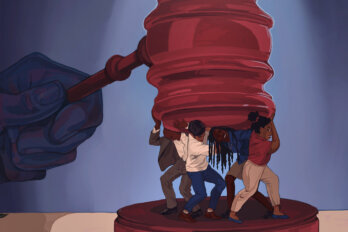On June 29, the Supreme Court of the United States effectively ended affirmative action by ruling that race could no longer be considered a factor in college admissions. The challenge had been brought by a group called Students for Fair Admissions. Its founder, conservative legal activist Edward Blum, “do[es] not believe” in systemic racism, according to an interview in the New York Times, and has spent years trying to weed out the concept of racial equity from American law. Less than two months after his legal victory against higher education, Blum turned to his next mark: diversity fellowships. In two querulous, virtually duplicate lawsuits, the plaintiff, American Alliance for Equal Rights—another Blum-led outfit—accused the law firms Morrison Foerster and Perkins Coie of perpetuating “rank discrimination” by earmarking certain fellowships for minoritized candidates.
The two defendants took the challenge very differently. In a statement to CNN, Perkins Coie pledged to “defend this lawsuit vigorously.” Morrison Foerster, which calls itself “MoFo” and won a 2023 “Outstanding Firm for Diversity & Inclusion” award from a legal research company, folded immediately and removed any specific references to race or queerness from the language of the job posting. However, their website’s robust workplace-culture page that trumpets the many faces of “MoFo Diversity”—including the banner announcing their big award—remains unchanged.
It’s common for legal professionals to extol diversity as a business asset—even if they cave as soon as someone holds their feet to the fire. Virtually every firm in Canada and the US has a Diversity and Equity tab on its website professing similar values. But attempts to move beyond mere lip service have historically been fraught. While big-law fellowships might look like an oddly specific thing to challenge, the move to weed out equitable hiring feeds into a much longer history of exclusion, one that has long shaped the legal profession in North America. As much as the field keeps saying it wants to change, its reaction in the face of controversy often suggests something different.
The demographics are already abysmal. According to the American Bar Association’s 2020 survey, 86 percent of all lawyers in the US were white. The Canadian Bar Association doesn’t keep comparable national figures. But 2019 statistics provided by various provincial law societies show that white lawyers made up an estimated 74.9 percent of those who practised in Ontario; in British Columbia, 16.15 percent of lawyers identified as a visible minority; and in Nova Scotia, 22 percent identified as members of an equity-seeking group. The high proportion of whiteness isn’t the result only of passivity or the failure to recruit more diverse candidates. It’s the remainder of deliberate historical attempts to bar women and people of colour from the profession.
In the US, Black lawyers were admitted to the American Bar Association only in 1943. Before you “meanwhile, in Canada” me, the Canadian legal field has perpetuated similar exclusions for centuries, just under sneakier guises. In a paper on the concept of legal professionalism, Constance Backhouse argues that power and exclusion are some of lawyering’s founding tenets. The idea of professionalism, she writes, “has been inextricably linked . . . to masculinity, whiteness, class privilege, and Protestantism.” In 1825, in order to be admitted to the Law Society of Upper Canada, candidates had to demonstrate a robust knowledge of classics, a barrier to entry that “carried unmistakable connotations of class, gender and race.” Who gets deemed worthy of making arguments in court, Backhouse says, has a bearing on the content of those arguments, the ensuing way the law develops, and which communities get access to justice.
These histories, and their legacy in the current makeup of the profession, coexist awkwardly with the way employers tend to talk about their DEI initiatives. In “Black on Bay Street,” a 2017 essay for the Globe and Mail, Hadiya Roderique dissects the elusive concept of “fit”—as in, a candidate’s ability to conform to a given workplace culture—and how, in hiring situations, “we end up defining fit, and thus merit, in our own image.” This makes joining the field an uphill battle for a non-white applicant, even though it’s hip for managers to talk a big game about their inclusive hiring practices. This was Roderique’s experience during her job hunt and even after she’d made it into a top-tier firm: employers “give the appearance of being hungry for qualified and diverse candidates,” she writes, “but their attempts fumble because . . . they hire people who fit into the firm as it already exists.” Even if someone does make it through the door—via the proactive gesture of an equity fellowship or not—making one token hire is a fundamentally different thing from changing the underlying culture of an institution.
Trying to kick-start a deeper kind of institutional change was the aim of a 2016 Law Society of Ontario (then called the Law Society of Upper Canada) report that investigated the challenges faced by racialized licensees. “Working Together for Change: Strategies to Address Issues of Systemic Racism in the Legal Professions” offered a suite of recommendations for making the field less hostile to lawyers of colour. One of these suggestions, for “every licensee to adopt and to abide by a statement of principles acknowledging their obligation to promote equality, diversity and inclusion,” attracted an outcry, with critics objecting to it as a form of compelled speech that violated their freedom of expression. A motion to make the statement voluntary failed, and the recommendation was later repealed entirely. A contingent of lawyers ran—successfully—for the Law Society bench, with the whole thrust of their platform being to oppose the statement of principles (SOP), calling themselves “StopSOP.” All that rancour—and, frankly, wasted time and effort—over asking lawyers to do something as cursory as admitting that diversity is okay. This is how inhospitable the industry can be: it’s comfortable gesturing to inclusion, but at the merest suggestion of something more proactive, it closes ranks.
Obviously, the lawyers who complained about the working group’s recommendation were inflating the threat to their speech and to their power. To oppose DEI initiatives, whether a simple statement of principles or something more concrete like a fellowship, is to treat these tools as more inherently progressive and capable of enacting large-scale change than they actually are. It is easy to paste a verbal commitment over a malign motive as a way of trying to make it look reasonable. Both legal language and expressions of diversity share this susceptibility to co-optation. Conservatives can slip it on like an ill-fitting garment, uncannily parroting familiar phrases: “I seek out individuals or jurisdictions [or] corporations who have been discriminated against in various endeavors because of their race and ethnicity,” Blum told the New York Times—which sounds reasonable until you realize the nominal “victims” he has in mind: straight white men and the empires they run.
By funnelling energy and resources toward attacking the bare minimum of equitable gestures, these positions steal our attention away from more effective methods of making organizations more equitable—methods like, say, affirmative action. The closed loop of making and shouting down statements professing to what you’re going to do is theatre that distracts from actually having to do it. For proof of the so-called power of a statement of principles, consider this: while every sector was putting out diversity statements in the latter half of 2020, the US Supreme Court was being stacked, and right-wing legal activists were mobilizing to topple one of the most powerful tools for actually addressing the field’s epidemic of whiteness. Too many people were looking in the wrong direction.





